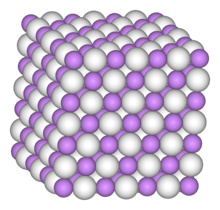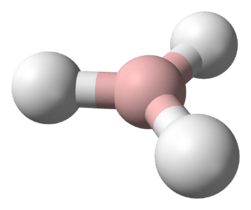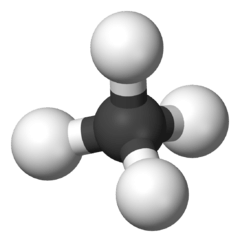Calcium monohydride
Calcium monohydride is a molecule composed of calcium and hydrogen with formula CaH. It can be found in stars as a gas formed when calcium atoms are present with hydrogen atoms.
 | |
| Names | |
|---|---|
| IUPAC name
Calcium monohydride | |
| Other names
Calcium(I) hydride | |
| Identifiers | |
3D model (JSmol) |
|
| ChemSpider | |
PubChem CID |
|
| |
| |
| Properties | |
| CaH | |
| Molar mass | 41.085899 g/mol |
| Appearance | glowing red gas |
| reacts violently | |
| Related compounds | |
Other cations |
Beryllium monohydride, Magnesium monohydride, Strontium monohydride, Barium monohydride, Potassium hydride |
| Calcium hydride | |
Except where otherwise noted, data are given for materials in their standard state (at 25 °C [77 °F], 100 kPa). | |
| Infobox references | |
Discovery
Calcium monohydride was first discovered when its spectrum was observed in Alpha Herculis and ο Ceti by Alfred Fowler in 1907.[1][2] It was observed in sunspots the following year by C. M. Olmsted.[3][4] Next, it was made in a laboratory in 1909 by A. Eagle,[3] and with early research by Hulthèn,[5] and Watson and Weber in 1935.[6] It was further observed in M dwarfs by Y. Öhman in 1934. Öhman proposed its use as a proxy for stellar luminosity, similar to magnesium monohydride (MgH), in being more apparent in the spectra of compact, cool, high surface gravity stars such as M dwarfs than in cool, low surface gravity stars such as M giants of non-negligible, or even comparable, metallicity.[7]
Calcium monohydride is the first molecular gas that was cooled by a cold buffer gas and then trapped by a magnetic field. This extends the study of trapped cold atoms such as rubidium to molecules.[8]
Formation
Calcium monohydride can be formed by exposing metallic calcium to an electric discharge in a hydrogen atmosphere above 750 °C. Below this temperature the hydrogen is absorbed to form calcium hydride.[3]
Calcium monohydride can be formed by laser ablation of calcium dihydride in a helium atmosphere.[9]
Gaseous calcium reacts with formaldehyde at temperatures around 1200 K to make CaH as well as some CaOH and CaO. This reaction glows orange-red.
Properties
The dipole moment of the CaH molecule is 2.94 debye.[10][11] Spectrographic constants have been measured as bond length Re=2.0025 Å dissociation energy De=1.837 eV and harmonic vibrational frequency ωe=1298.34 cm−1.[10] Ionisation potential is 5.8 eV.[10] Electron affinity is 0.9 eV.[10]
The ground state is X2Σ+.[10]
The electronic states are:[12]
- 6σ27σ X2Σ+[13]
- 6σ23π A2Π
- 6σ28σ B2Σ+
- 6σ24π E2Π
- 6σ7σ2 D2Σ+
Spectrum
B2Σ, with ν'=0 ← X2Σ with ν"=0 634 nm (or is it 690 nm?)[14] CaH fluoresces with 634 nm light giving 690 nm emissions.[9]
B2Σ+ ← X2Σ+ 585.8 nm to 590.2 nm.[15]
A+2Π ← X2Σ+ 686.2 to 697.8 nm[15]
R12 branch[15]
| J' | J" | N" | ν | nm | THz |
|---|---|---|---|---|---|
| 3/2 | 1/2 | 0 | 14408.94 | 694.0135 | 431.9691 |
| 5/2 | 3/2 | 1 | 14421.12 | 693.4274 | 432.3343 |
| 7/2 | 5/2 | 2 | 14432.92 | 692.8605 | 432.6881 |
| 9/2 | 7/2 | 3 | 14444.54 | 692.3031 | 433.0364 |
| 11/2 | 9/2 | 4 | 14455.76 | 691.7658 | 433.3728 |
| 13/2 | 11/2 | 5 | 14467.20 | 691.2188 | 433.71574 |
R2 branch[15]
| J' | J" | N" | ν | nm | THz |
|---|---|---|---|---|---|
| 3/2 | 1/2 | 0 | 14480.93 | 690.5633 | 434.1274 |
| 5/2 | 3/2 | 1 | 14495.08 | 689.8893 | 434.5516 |
| 7/2 | 5/2 | 2 | 14510.09 | 689.1756 | 435.0015 |
| 9/2 | 7/2 | 3 | 14525.53 | 688.4430 | 435.4644 |
| 11/2 | 9/2 | 4 | 14541.43 | 687.6903 | 435.9411 |
| 13/2 | 11/2 | 5 | 14557.98 | 686.9085 | 436.4373 |
C2Σ+ →X2Σ+ transition is in near ultraviolet.[3]
Microwave spectrum
The energy required to spin the CaH molecule from its lowest level to the first quantum level corresponds to a microwave frequency, so there is an absorption around 253 GHz. However, the spin of the molecule is also affected by the spin of an unpaired electron on the calcium, and the spin of the proton in the hydrogen. The electron spin leads to splitting of the line by about 1911.7 MHz, and the spin relative to the proton spin results in hyperfine splitting of the line by about 157.3 MHz.[16]
| molecule spin quantum number |
electron spin quantum number |
proton spin quantum number |
frequency | |||
| N | N' | J | J' | F | F' | kHz |
| 0 | 1 | 1/2 | 1/2 | 1 | 1 | 252163082 |
| 0 | 1 | 1/2 | 1/2 | 1 | 0 | 252216347 |
| 0 | 1 | 1/2 | 1/2 | 0 | 1 | 252320467 |
| 0 | 1 | 1/2 | 3/2 | 1 | 1 | 254074834 |
| 0 | 1 | 1/2 | 3/2 | 1 | 2 | 254176415 |
| 0 | 1 | 1/2 | 3/2 | 0 | 1 | 254232179 |
Reactions
CaH reacts with Lithium as a cold gas releasing 0.9eV of energy and forming LiH molecules and calcium atoms.[17]
Extra reading
- Calvin, Aaron T.; Janardan, Smitha; Condoluci, John; Rugango, Réne; Pretzsch, Eric; Shu, Gang; Brown, Kenneth R. (16 March 2018). "Rovibronic Spectroscopy of Sympathetically Cooled40CaH". The Journal of Physical Chemistry A. 122 (12): 3177–3181. Bibcode:2018JPCA..122.3177C. doi:10.1021/acs.jpca.7b12823. PMID 29521505.
References
- Barbuy, B.; Schiavon, R. P.; Gregorio-Hetem, J.; Singh, P. D.; Batalha, C. (October 1993). "Intensity of CaH Lines in Cool Dwarfs". Astronomy and Astrophysics Supplement Series. 101 (2): 409. Bibcode:1993A&AS..101..409B.
- Fowler, A. (1907). "The fluted spectrum of titanium oxide". Proceedings of the Royal Society A. 79 (533): 509–18. Bibcode:1907RSPSA..79..509F. doi:10.1098/rspa.1907.0059.
- Frum, C.I.; H.M. Pickett (1993). "High-Resolution Infrared Fourier Transform Emission Spectroscopy of Metal Hydrides: X2Σ+ state of CaH". Journal of Molecular Spectroscopy. 159 (2): 329–336. Bibcode:1993JMoSp.159..329F. doi:10.1006/jmsp.1993.1130.
- Olmsted, Charles M. (1908). "Sun-spot bands which appear in the spectrum of a calcium arc burning in the presence of hydrogen". Contributions from the Solar Observatory of the Carnegie Institution of Washington. 21: 1–4. Bibcode:1908CMWCI..21....1O.
- Hulthèn, E. (1 January 1927). "On The Band Spectrum of Calcium Hydride". Physical Review. 29 (1): 97–111. Bibcode:1927PhRv...29...97H. doi:10.1103/PhysRev.29.97.
- Watson, William; Weber, Robert (1 November 1935). "The E Band System of Calcium Hydride". Physical Review. 48 (9): 732–734. Bibcode:1935PhRv...48..732W. doi:10.1103/PhysRev.48.732.
- Öhman, Yngve (October 1934). "Spectrographic Studies in the Red". Astrophysical Journal. 80: 171. Bibcode:1934ApJ....80..171O. doi:10.1086/143595.
- Bretislav Friedrich; John M. Doyle (2009). "Why are Cold Molecules so Hot?". ChemPhysChem. 10 (4): 604–623. doi:10.1002/cphc.200800577. PMID 19229896.
- Doyle, John M.; Jonathan D. Weinstein; Robert deCarvalho; Thierry Guillet; Bretislav Friedrich (1998). "Magnetic trapping of calcium monohydride molecules at millikelvin temperatures". Nature. 395 (6698): 148–150. Bibcode:1998Natur.395..148W. doi:10.1038/25949.
- Holka, Filip; Miroslav Urban (2006). "The dipole moment and molecular properties of CaH: A theoretical study". Chemical Physics Letters. 426 (4–6): 252–256. Bibcode:2006CPL...426..252H. doi:10.1016/j.cplett.2006.05.108.
- Steimle, T. C.; Jinhai Chen; Jamie Gengler (2004-07-08). "The permanent electric dipole moments of calcium monohydride, CaH". The Journal of Chemical Physics. 121 (2): 829–834. Bibcode:2004JChPh.121..829S. doi:10.1063/1.1759314. PMID 15260612.
- Ram, R.S.; Tereszchuk, K.; Gordon, I.E.; Walker, K.A.; Bernath, P.F. (2011). "Fourier transform emission spectroscopy of the E2Π–X2Σ+ transition of CaH and CaD". Journal of Molecular Spectroscopy. 266 (2): 86–91. Bibcode:2011JMoSp.266...86R. doi:10.1016/j.jms.2011.03.009.
- Gordon, I.; Ram, R. S.; Tereszchuk, K.; Walker, K. A.; Bernath, P. F. (1 April 2011). "Fourier Transform Emission Spectroscopy of the E2Π–X2Σ+ System of CaH and CaD". hdl:1811/49445. Cite journal requires
|journal=(help) - Berg, L-E; L Klynning (1974). "Rotational Analysis of the A-X and B-X Band Systems of CaH". Physica Scripta. 10 (6): 331–336. Bibcode:1974PhyS...10..331B. doi:10.1088/0031-8949/10/6/009.
- Pereira, R.; S. Skowronek; A. González Ureña; A. Pardo; J.M.L. Poyato; A.H. Pardo (2002). "Rotationally Resolved REMPI Spectra of CaH in a Molecular Beam". Journal of Molecular Spectroscopy. 212 (1): 17–21. Bibcode:2002JMoSp.212...17P. doi:10.1006/jmsp.2002.8531.
- Barclay, W. L., Jr.; Anderson, M. A.; Ziurys, L. M. (1993). "The millimeter-wave spectrum of CaH (X 2Σ+)". Astrophysical Journal Letters. 408 (1): L65–L67. Bibcode:1993ApJ...408L..65B. doi:10.1086/186832.
- Singh, Vijay; Kyle S. Hardman; Naima Tariq; Mei-Ju Lu; Aja Ellis; Muir J. Morrison; Jonathan D. Weinstein (2012). "Chemical Reactions of Atomic Lithium and Molecular Calcium Monohydride at 1 K". Physical Review Letters. 108 (20): 203201. Bibcode:2012PhRvL.108t3201S. doi:10.1103/PhysRevLett.108.203201. PMID 23003146.






